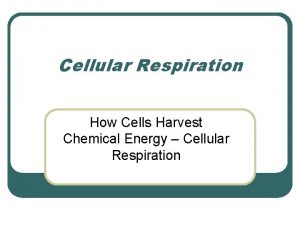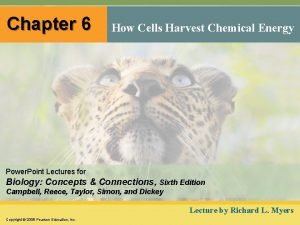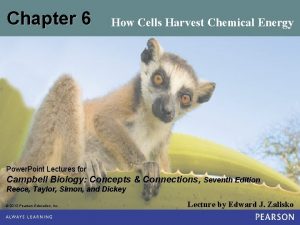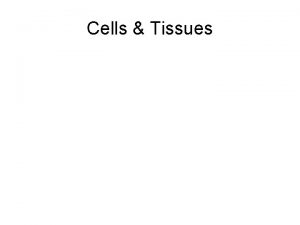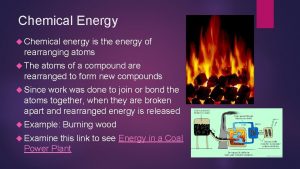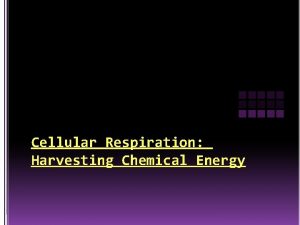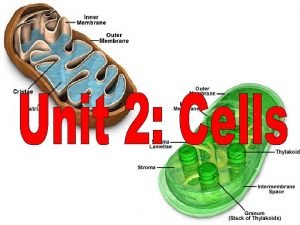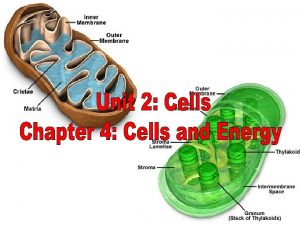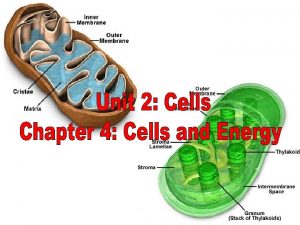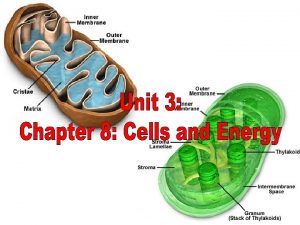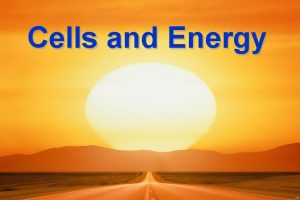UNIT 4 Cells and Energy I Chemical Energy














- Slides: 14


UNIT 4: Cells and Energy I. Chemical Energy and ATP A. The chemical energy used for most cell processes is carried by ATP 1. All carbon-based molecules in food store chemical energy in their bonds

a. Carbohydrates and lipids most important energy sources. b. Energy comes from food indirectly

2. All cells use energy carried by ATP a. ATP (adenosine triphosphate) is molecule that transfers energy from breakdown of food b. ATP carries energy cells can use c. Used for building molecules, moving materials by active transport, etc. d. adenine, ribose and 3 phosphate groups

3. Energy of ATP released when phosphate group is removed a. Bond holding third phosphate group is unstable and very easily broken

b. When loses 3 rd phosphate group, ATP become ADP (adenosine diphosphate) 1) ADP is a lower energy molecule than ATP 2) Can be converted back into ATP with addition of energy (adding phosphate group)

3) The breakdown of ATP to ADP and production of ATP from ADP can be represented by cycle. 4) This requires complex group of proteins to help.

The most important energy storing compound is ATP A P P P Energy ADP +P A P P P

B. Organisms break down carbon-based molecules to produce ATP 1. Food you eat does not contain ATP a. Food must first be digested (break down into smaller molecules) b. Foods provide different amounts of energy (calories)

2. Number of ATP molecules depends on type of molecule broken down (Carbohydrate, Protein, Lipid) a. Carbohydrates most commonly broken down to make ATP b. Break down of glucose yields 36 molecules of ATP

3. Fats store about 80% of energy in your body a. When broken down, yield the most ATP b. A typical triglyceride yields about 146 molecules of ATP

4. Proteins have about as much ATP as carbohydrates a. Less likely to be broken down b. Amino acids needed to build new proteins

5. Plants also need ATP a. Plants do not eat to obtain energy b. Use energy produced by photosynthesis (make sugars from sunlight)

C. A few types of organisms do not need sunlight and photosynthesis as a source of energy 1. Some organisms use chemosynthesis to produce energy (sugars) 2. Used by organisms in hydrothermal vents (deep ocean)
 How cells harvest chemical energy
How cells harvest chemical energy Chapter 6 how cells harvest chemical energy
Chapter 6 how cells harvest chemical energy How cells harvest chemical energy chapter 6
How cells harvest chemical energy chapter 6 Development of paranasal sinuses
Development of paranasal sinuses Chlorocruorin
Chlorocruorin Plant cell animal cell venn diagram
Plant cell animal cell venn diagram Masses of cells form and steal nutrients from healthy cells
Masses of cells form and steal nutrients from healthy cells Loop of henle
Loop of henle Parafollicular cells vs follicular cells
Parafollicular cells vs follicular cells How are somatic cells different from gametes
How are somatic cells different from gametes Somatic cells vs germ cells
Somatic cells vs germ cells Eukaryotic cells vs prokaryotic cells
Eukaryotic cells vs prokaryotic cells Prokaryotic vs eukaryotic cells venn diagram
Prokaryotic vs eukaryotic cells venn diagram The organelle trail
The organelle trail Label
Label
